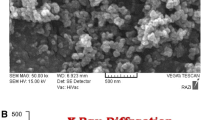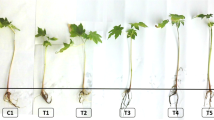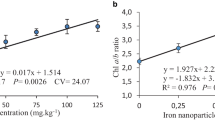Abstract
Due to its wide industrial application, chromium (Cr) is known to be a critical environmental pollutant. Contamination of water and agricultural soil by Cr inhibits crop productivity and their physiological and biochemical processes. The objective of the current work was to investigate the effects of appropriate reducing agents such as EDTA, iron sulfate (Fe2+), and zerovalent nano iron (Fe0 nanoparticles) on growth and physiology of sunflower plants under Cr(VI) stress. Results showed that the Cr uptake increased by increasing the amount of EDTA, leading to a significant reduction in morphological and physiological parameters except for MDA and H2O2 contents. Treatment with Fe0 nanoparticles and Fe2+ reduced Cr concentration in root and shoot, increased root and shoot dry weight, plastid pigments (chlorophyll and carotenoids) and proline contents; however, the level of MDA and H2O2 decreased significantly. All parameters were affected by Fe2+ during the first week of sampling; however, Fe0 nanoparticles affected all traits until the end of the third sampling stage. A statistically significant and positive correlation was found between root Cr concentration and MDA and H2O2 seedlings treated with EDTA, Fe2+, and Fe0 grown under Cr stress. From the result of this study, it can be concluded that sunflower has the potential for accumulation of Cr as a heavy metal, and treatment with Fe0 nanoparticles to prevent Cr uptake is more effective than other employed treatments.






Similar content being viewed by others
References
Antonkiewicz J, Jasiewicz C, Koncewicz-Baran M, Sendor R (2016a) Nickel bioaccumulation by the chosen plant species. Acta Physiol Plant 38(40):11
Antonkiewicz J, Kołodziej B, Bielińska E (2016b) The use of reed grass and giant miscanthus in the phytoremediation of municipal sewage sludge. Environ Sci Pollut Res 23(10):9505–9517
Arora A, Sairam R, Srivastava G (2002) Oxidative stress and antioxidative system in plants. Curr Sci Bangalore 82:1227–1238
Baker AJ, McGrath S, Reeves RD, Smith J, Terry N, Bañuelos G (2000) A review of the ecology and physiology of a biological resource for phytoremediation of metal polluted soils. In: Terry N, Banuelos G, Vangronsveld J (eds) Phytoremediation of contaminated soil and water. CRC Press, Boca Raton, pp 85–107
Barnhart J (1997) Chromium chemistry and implications for environmental fate and toxicity. Soil Sediment Contam 6:561–568
Barton LL, Johnson GV, O’Nan AG, Wagener BM (2000) Inhibition of ferric chelate reductase in alfalfa roots by cobalt, nickel, chromium, and copper. J Plant Nutr 23:1833–1845
Bates L, Waldren R, Teare I (1973) Rapid determination of free proline for water-stress studies. Plant Soil 39:205–207
Bishnoi N, Chugh L, Sawhney S (1993) Effect of chromium on photosynthesis, respiration and nitrogen fixation in pea (Pisum sativum L.) seedlings. J Plant Physiol 142:25–30
Blaylock MJ, Salt DE, Dushenkov S, Zakharova O, Gussman C, Kapulnik Y, Ensley BD, Raskin I (1997) Enhanced accumulation of Pb in Indian mustard by soil-applied chelating agents. Environ Sci Technol 31:860–865
Chen H, Cutright T (2001) EDTA and HEDTA effects on Cd, Cr, and Ni uptake by Helianthus annuus. Chemosphere 45:21–28
Chen H, Cutright TJ (2002) The interactive effects of chelator, fertilizer and rhizobacteria for enhancing phytoremediation of heavy metal contaminated soil. J Soils Sedim 2:203–210
Chen LM, Lin CC, Kao CH (2000) Copper toxicity in rice seedlings: changes in antioxidative enzyme activities, H2O2 level, and cell wall peroxidase activity in roots. Bot Bull Acad Sin 41:99–103
Cohen MD, Kargacin B, Klein CB, Costa M (1993) Mechanisms of chromium carcinogenicity and toxicity. Crit Rev Toxicol 23:255–281
Connell SL, Al-Hamdani SH (2001) Selected physiological responses of kudzu to different chromium concentrations. Can J Plant Sci 81:53–58
Contin M, Mondini C, Leita L, De Nobili M (2007) Enhanced soil toxic metal fixation in iron (hydr) oxides by redox cycles. Geoderma 140:164–175
Contin M, Mondini C, Leita L, Zaccheo P, Crippa L, De Nobili M (2008) Immobilisation of soil toxic metals by repeated additions of Fe(II) sulphate solution. Geoderma 147:133–140
Davies F, Puryear J, Newton R, Egilla J, Saraiva Grossi J (2002) Mycorrhizal fungi increase chromium uptake by sunflower plants: influence on tissue mineral concentration, growth, and gas exchange. J Plant Nutr 25:2389–2407
Desikan R, Cheung MK, Bright J, Henson D, Hancock JT, Neill SJ (2004) ABA, hydrogen peroxide and nitric oxide signalling in stomatal guard cells. J Exp Bot 55:205–212
Dube B, Tewari K, Chatterjee J, Chatterjee C (2003) Excess chromium alters uptake and translocation of certain nutrients in citrullus. Chemosphere 53:1147–1153
Elless M, Blaylock M (2000) Amendment optimization to enhance lead extractability from contaminated soils for phytoremediation. Int J Phytoremediation 2:75–89
Frossard R (1993) Contaminant uptake by plants. Soil monitoring. Springer, pp 157–178
GeoNano Environ. Tech. Inc. (2007) gnet.myweb.hinet.net/company2(E).html. Accessed 27 Jul 2009
Ghani A (2011) Effect of chromium toxicity on growth, chlorophyll and some mineral nutrients of Brassica juncea L. Egypt Acad J Biol Sci 2:9–15
Ghosh M, Singh S (2005) Comparative uptake and phytoextraction study of soil induced chromium by accumulator and high biomass weed species. App Ecol Environ Res 3:67–79
Gomesa MAC, Hauser-Davisb RA, Suzukia MS, Vitoriaa AP (2017) Plant chromium uptake and transport, physiological effects and recent advances in molecular investigations. Ecotoxicol Environ Saf 140:55–64
Grene R (2002) Oxidative stress and acclimation mechanisms in plants. The Arabidopsis Book, e0036
Gupta DK, Srivastava A, Singh V (2008) EDTA enhances lead uptake and facilitates phytoremediation by vetiver grass. J Environ Biol 29:903–906
Hanus J, Tomas J (1993) An investigation of chromium content and its uptake from soil in white mustard. Acta Fytotech 48:39–47
Hatami M, Ghorbanpour M (2014) Defense enzyme activities and biochemical variations of Pelargonium zonale in response to nanosilver application and dark storage. Turk J Biol 38:130–139
Hatami M, Hadian J, Ghorbanpour M (2017) Mechanisms underlying toxicity and stimulatory role of single-walled carbon nanotubes in Hyoscyamus niger during drought stress simulated by polyethylene glycol. J Hazard Mater 324:306–320
Heath RL, Packer L (1968) Photoperoxidation in isolated chloroplasts: I. Kinetics and stoichiometry of fatty acid peroxidation. Arch Biochem Biophys 125:189–198
Hong F, Zhou J, Liu C, Yang F, Wu C, Zheng L, Yang P (2005) Effect of nano-TiO2 on photochemical reaction of chloroplasts of spinach. Biol Trace Elem Res 105:269–279
Huang JW, Chen J, Berti WR, Cunningham SD (1997) Phytoremediation of lead-contaminated soils: role of synthetic chelates in lead phytoextraction. Environ Sci Technol 31:800–805
Kirkham M (2006) Cadmium in plants on polluted soils: effects of soil factors, hyperaccumulation, and amendments. Geoderma 137:19–32
Kocik K, Ilavsky J (1994) Effect of Sr and Cr on the quantity and quality of the biomass of field crops. Production and utilization of agricultural and forest biomass for energy: proceedings of a seminar held at Zvolen, Slovakia, pp 168–178
Kumpiene J (2005) Assessment of trace element stabilization in soil. Sci Technol 30:248–251
Kumpiene J, Ore S, Renella G, Mench M, Lagerkvist A, Maurice C (2006) Assessment of zerovalent iron for stabilization of chromium, copper, and arsenic in soil. Environ Pollut 144:62–69
Kumpiene J, Lagerkvist A, Maurice C (2008) Stabilization of As, Cr, Cu, Pb and Zn in soil using amendments—a review. Waste Manage 28:215–225
Lelie DVD, Schwitzguébel JP, Glass DJ, Vangronsveld J, Baker A (2001) Assessing phytoremediation’s progress in the United States and Europe. Environ Sci Technol 35:446–452
Lin ZQ, Schemenauer RS, Cervinka V, Zayed A, Lee A, Terry N (2000) Selenium volatilization from a soil plant system for the rem ediation of contaminated water and soil in the San Joaquin Valley. J Environ Qual 29:1048–1056
Lichtenthaler H, Wellburn A (1983) Determinations of total carotenoids and chlorophylls a and b of leaf extracts in different solvents. Biochem Soc Trans 11:591–592
Liu R, Zhao D (2007a) In situ immobilization of Cu (II) in soils using a new class of iron phosphate nanoparticles. Chemosphere 68:1867–1876
Liu R, Zhao D (2007b) Reducing leachability and bioaccessibility of lead in soils using a new class of stabilized iron phosphate nanoparticles. Water Res 41:2491–2502
Lodeiro P, Fuentes A, Herrero R, de Vicente MES (2008) CrIII binding by surface polymers in natural biomass: the role of carboxylic groups. Environ Chem 5:355–365
Luo C, Shen Z, Li X (2005) Enhanced phytoextraction of Cu, Pb, Zn and Cd with EDTA and EDDS. Chemosphere 59:1–11
Meier U (2001) Growth stages of mono-and dicotyledonous plants. BBCH monograph. Federal Biological Research Centre for Agriculture and Forestry. 2 edn. https://doi.org/10.5073/bbch0515
Meyer D, Bhattacharyya D, Bachas L, Ritchie S (2005) Membrane-based nanostructured metals for reductive degradation of hazardous organics. ACS symposium series. Oxford University Press, pp 256–261
Moraru CI, Panchapakesan CP, Huang Q, Takhistov P, Sean L, Kokini JL (2003) Nanotechnology: a new frontier in food science. Food Technol 57:24–29
Motasharrezadeh B (2008) Studying the possibility of increasing the efficiency of phytoremediation of soil contaminated with heavy metals by biological agents. Ph.D thesis in Soil Science, Tehran University, Karaj, Iran.
Panda S, Choudhury S (2005) Chromium stress in plants. Braz J Plant Physiol 17:95–102
Panda S, Patra H (2000) Nitrate and ammonium ions effect on the chromium toxicity in developing wheat seedlings. Proc Natl Acad Sci India Sec B Biol Sci 70:75–80
Pandey N, Sharma CP (2003) Chromium interference in iron nutrition and water relations of cabbage. Environ Exp Bot 49:195–200
Priyadarshini S, Deepesh B, Zaidi MGH, Pardha Saradhi P, Khanna PK, Arora S (2012) Silver nanoparticle-mediated enhancement in growth and antioxidant status of Brassica juncea. Appl Biochem Biotech 167:2225–2233
Qian G, Chen W, Lim TT, Chui P (2009) In-situ stabilization of Pb, Zn, Cu, Cd and Ni in the multi-contaminated sediments with ferrihydrite and apatite composite additives. J Hazard Mater 170:1093–1100
Racuciu M, Creanga DE (2007) TMA-OH coated magnetic nanoparticles internalized in vegetal tissue. Rom J Phys 52:395–402
Römkens P, Bouwman L, Japenga J, Draaisma C (2002) Potentials and drawbacks of chelate-enhanced phytoremediation of soils. Environ Pollut 116:109–121
Sairam R, Saxena D (2000) Oxidative stress and antioxidants in wheat genotypes: possible mechanism of water stress tolerance. J Agron Crop Sci 184:55–61
Shanker AK, Cervantes C, Loza-Tavera H, Avudainayagam S (2005) Chromium toxicity in plants. Environ Int 31:739–753
Sinha S, Saxena R, Singh S (2005) Chromium induced lipid peroxidation in the plants of Pistia stratiotes L.: role of antioxidants and antioxidant enzymes. Chemosphere 58:595–604
Sundaramoorthy P, Chidambaram A, Ganesh KS, Unnikannan P, Baskaran L (2010) Chromium stress in paddy:(i) nutrient status of paddy under chromium stress; (ii) phytoremediation of chromium by aquatic and terrestrial weeds. C R Biol 333:597–607
Tandy S, Schulin R, Nowack B (2006) The influence of EDDS on the uptake of heavy metals in hydroponically grown sunflowers. Chemosphere 62:1454–1463
Tucker M (1974) A modified heating block foe plant tissue digestion 1. Commun Soil Sci Plant Anal 5:539–546
Velikova V, Yordanov I, Edreva A (2000) Oxidative stress and some antioxidant systems in acid rain-treated bean plants: protective role of exogenous polyamines. Plant Sci 151:59–66
Wu L, Luo Y, Xing X, Christie P (2004) EDTA-enhanced phytoremediation of heavy metal contaminated soil with Indian mustard and associated potential leaching risk. Agric Ecosyst Environ 102:307–318
Xu Y, Zhao D (2007) Reductive immobilization of chromate in water and soil using stabilized iron nanoparticles. Water Res 41:2101–2108
Yadav S (2010) Heavy metals toxicity in plants: an overview on the role of glutathione and phytochelatins in heavy metal stress tolerance of plants. S Afr J Bot 76:167–179
Zavoda J, Cutright T, Szpak J, Fallon E (2001) Uptake, selectivity and inhibition of hydroponic treatment of contaminants. J Environ Eng 127:502–508
Zayed A, Lytle CM, Qian JH, Terry N (1998) Chromium accumulation, translocation and chemical speciation in vegetable crops. Planta 206:293–299
Zhang WX (2003) Nanoscale iron particles for environmental remediation: an overview. J Nanopart Res 5:323–332
Acknowledgements
This study was financially supported by Deputy of Research and Technology of Azarbaijan Shahid Madani University (217/D/10965), Tabriz, Iran.
Author information
Authors and Affiliations
Corresponding author
Additional information
Communicated by A. Krolicka.
Rights and permissions
About this article
Cite this article
Mohammadi, H., Hatami, M., Feghezadeh, K. et al. Mitigating effect of nano-zerovalent iron, iron sulfate and EDTA against oxidative stress induced by chromium in Helianthus annuus L.. Acta Physiol Plant 40, 69 (2018). https://doi.org/10.1007/s11738-018-2647-2
Received:
Revised:
Accepted:
Published:
DOI: https://doi.org/10.1007/s11738-018-2647-2




